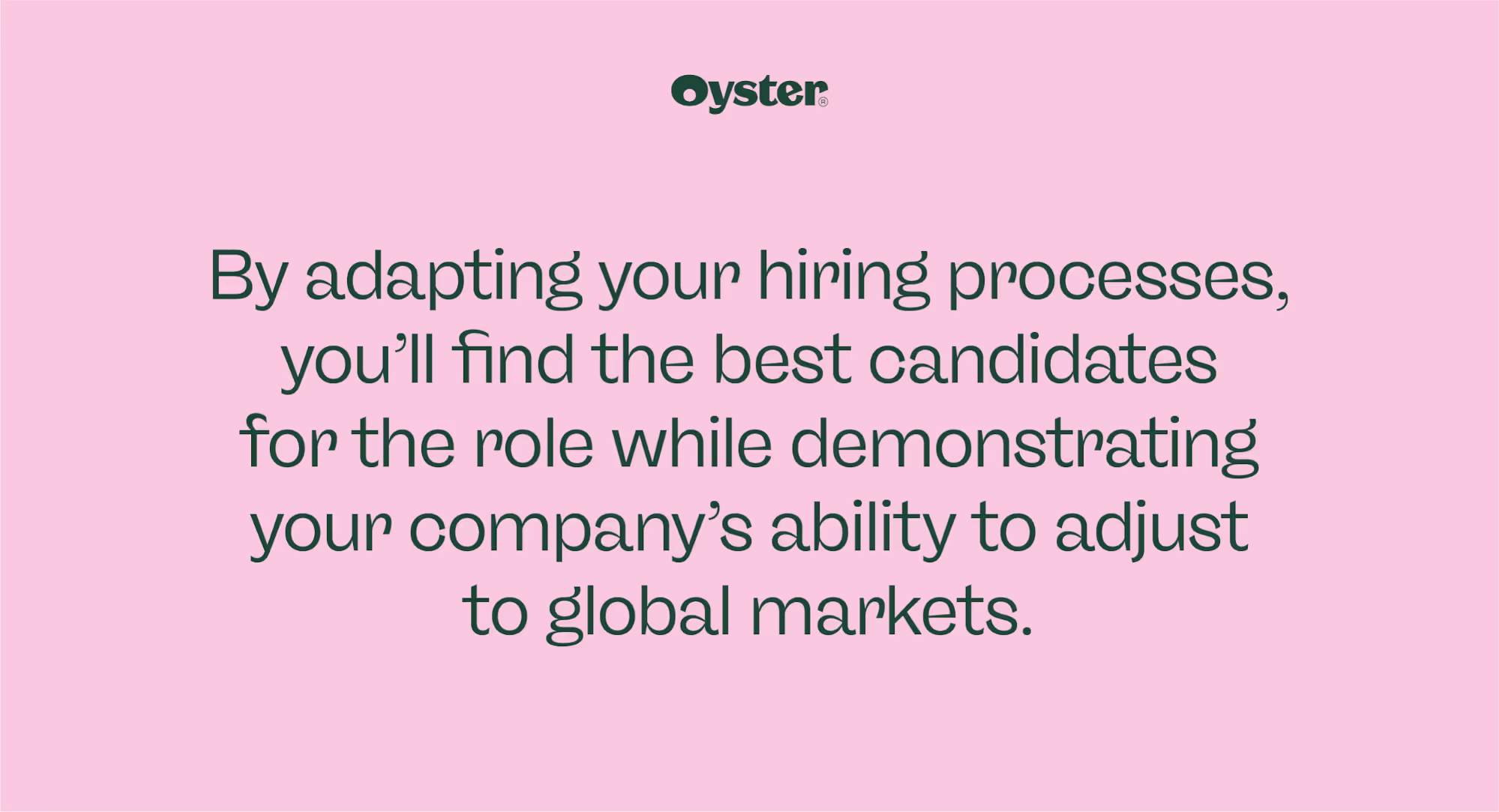Diversity is shaping the future of recruiting. LinkedIn reported that their data shows 78% of companies value diversity as very/extremely important. One major way that companies can increase their diversity is by hiring international employees, bringing fresh perspectives and valuable experience to their teams.
As the world embraces a remote workforce, the barriers to hiring global employees continue to fall. With a distributed team, it makes little difference if an employee is based out of New York or Colombia. So why aren’t we seeing more companies with international employees? Unfortunately, old ideas and beliefs about hiring globally remain, despite the advances that technology and globalization have afforded businesses.
There are several challenges to hiring global employees, but misinformation shouldn’t be one of them. In this article, you’ll learn about some of the common misconceptions companies have about hiring internationally, and why they are generally wrong.

Myth 1: There’s no need to hire global employees
Why limit your company’s access to top talent? With the communication technologies that exist today to connect teams across continents, there is no reason that you shouldn’t or can’t expand the geographic scope of your company’s hiring efforts. Your company will also benefit from the diversity of perspectives that foreign employees offer, including cultural sensitivity. The benefit is even greater for companies that are looking to expand to international consumers.

Myth 2: Hiring global employees is difficult
Perhaps the most intimidating aspect of hiring globally is the work that companies need to put in to avoid compliance issues. All of the different laws and regulations can appear daunting at first. Luckily, there are companies that can help you navigate the various requirements so that your company can hire confidently. Global employment platforms like Oyster can help you hire and onboard Team Members across borders. Working with people and companies that are familiar with the international requirements makes hiring global employees no more difficult than hiring domestically.

Myth 3: The process of hiring global employees is slow and expensive
Depending on the combination of skill sets you want your next hire to have, it may actually be faster to hire a global employee. For example, if you need someone who can quickly communicate with overseas manufacturers or someone with specific experiences in science, tech, and engineering, you might be able to fill a vacant role faster by hiring internationally. Hiring globally can often be the fastest solution to local labor shortages.

Myth 4: Local employees have a greater chance of succeeding in the workplace
When hiring, many employers look for candidates that they can onboard quickly. Some employers may believe that the added challenges of assimilation will negatively affect a foreign employee’s chance of succeeding. This is not necessarily the case.
Workplaces that offer the appropriate support, an inclusive culture, and development tools can allow any employee the opportunity to thrive. Employee success should primarily be determined by skill and job alignment, ambition, and experience level. In reality, the country an employee is from has little to do with the factors that contribute to a successful hire.

Myth 5: The unique backgrounds and experiences global employees bring can create challenges within the team
A diversity of backgrounds on a team offers more opportunities for creative thinking, thoughtful collaboration, and new perspectives. Consider how employees from Eastern and Western countries can learn from each other and how they each bring unique cultural values to the table. For example, in Eastern work culture, harmony in the workplace is highly valued and confrontation is less common than in Western work culture. Where the Eastern employee can learn candor, the Western employee can learn conflict management. What may have once been thought of as a challenge can be reframed as learning opportunities on diversified teams.

Myth 6: Only large businesses should hire global employees

One myth about hiring global employees is that only big companies have the resources or the need to hire internationally. While some companies hire entire teams—for example, offshoring their entire customer support services division— hiring globally can take many different forms, leveraging hybrid work to fill gaps across business functions.
The truth is that the size of the company should not be the focus when determining whether your company should hire global employees. The focus should be on hiring the best talent, regardless of location. Even smaller companies can benefit from the diverse points of view that hiring globally brings to your team. With an abundance of digital tools and resources available today, even small companies can make international recruitment a reality.

Myth 7: Global hiring is only suitable for non-managerial roles
Diversity among management is important for any company. Great managerial talent exists all over and it can bring new insights and perspectives to your business. The breadth of experience creates more opportunities for creative solutions and problem-solving. Hiring globally for leadership and managerial positions also ensures that your company can strategically account for and adjust to cultural differences and nuances that your audience experiences.
Diversity within management acts like a magnet for diverse employees and customers. Consumers tend to be attracted to companies that reflect their values. Similarly, diverse jobseekers will look for companies where they can show up authentically and still be successful. The best way for any company to demonstrate this commitment to creating an inclusive environment is by demonstrating diversity within all levels of the organization.
If there’s a scarcity of talent with the type of leadership experience your company needs, then isn’t it worth searching beyond your borders to find the best leadership talent?

Myth 8: Global employees take jobs from local talent
Hiring internationally doesn’t necessarily mean that you are taking a job away from local or domestic employees. Often, companies look abroad when they encounter a local skill gap or reduced pool of qualified candidates for an important role.
Hiring global employees allows local companies to benefit from the expertise, experience, and knowledge of highly skilled global talent. With the right talent, businesses can thrive and create even more job opportunities for domestic and international employees. International employees should not be feared, but rather embraced by countries looking to expand their business sector.

Myth 9: There’s no need to change recruitment strategies when hiring globally

Hiring globally requires that companies adopt thoughtful and intentional hiring practices. Oftentimes a job post will disproportionately attract candidates from specific locationss, normally skewing local and domestic. To reach a global audience, you need to broaden your recruitment methods, promote your diversity and inclusion policy, and evaluate your job posting for inclusivity.
It is important to consider the cultural contexts within which you will be hiring, and your recruitment strategy should remain flexible to fit the expectations of the international applicants. By adapting your hiring processes, you’ll find the best candidates for any role while demonstrating your company’s ability to adjust to global markets.
Research is an important component of building an effective international recruitment strategy. Your company should do research to understand local economies and networks, to identify the best sources for candidates, and to draft job descriptions that adopt an appropriate tone and outlines the basic salary and benefits offered.

Myth 10: Existing employees are already prepared to integrate with new global employees
If you’re conducting your first international hire, then you’ll need to prepare your existing team to engage and onboard the new team member(s). Distributed teams may need extra support and preparation to overcome communication challenges that inherently accompany remote work. Luckily, there are lots of cultural training programs available to promote intercultural communication. Oyster also offers distributed work courses to help you set your team up for success by improving how well everyone works together.
Conclusion
It takes effort and intentionality to hire global employees, but the payoffs of diverse perspectives, in-demand skills and knowledge sharing, and inclusive work environments make it worthwhile. Even though some challenges remain, there are many resources available to help any company, regardless of size, successfully recruit and hire global employees without high costs or excessive time commitments.
Looking for a tool to help you hire and onboard your international employees? Oyster provides expert services, tools, and advice to companies looking for the best talent, making global hiring effortless for employers. See for yourself!
About Oyster
Oyster is a global employment platform designed to enable visionary HR leaders to find, hire, pay, manage, develop, and take care of a thriving distributed workforce. Oyster lets growing companies give valued international team members the experience they deserve, without the usual headaches and expense.
Oyster enables hiring anywhere in the world—with reliable, compliant payroll, and great local benefits and perks.







